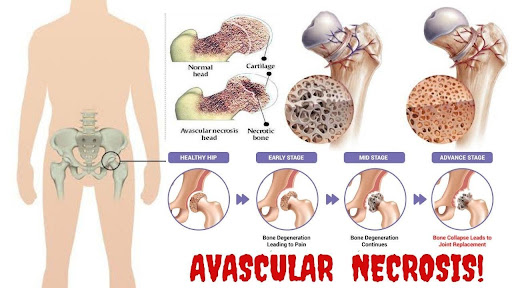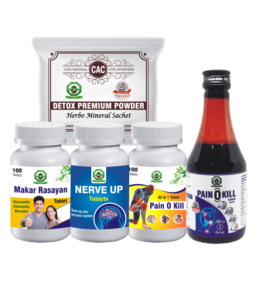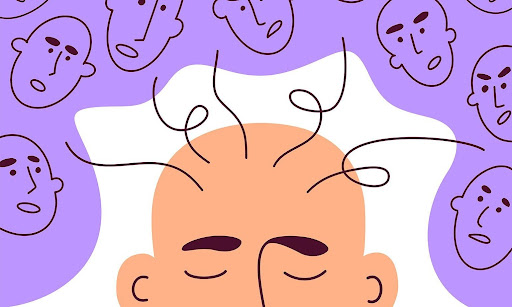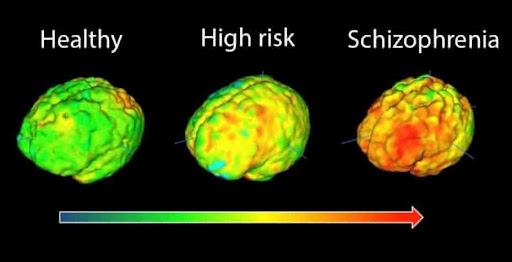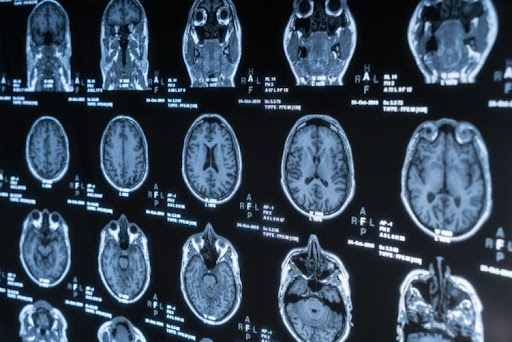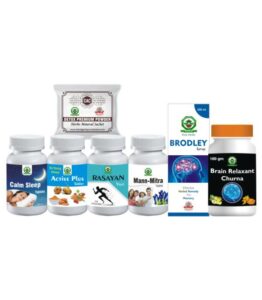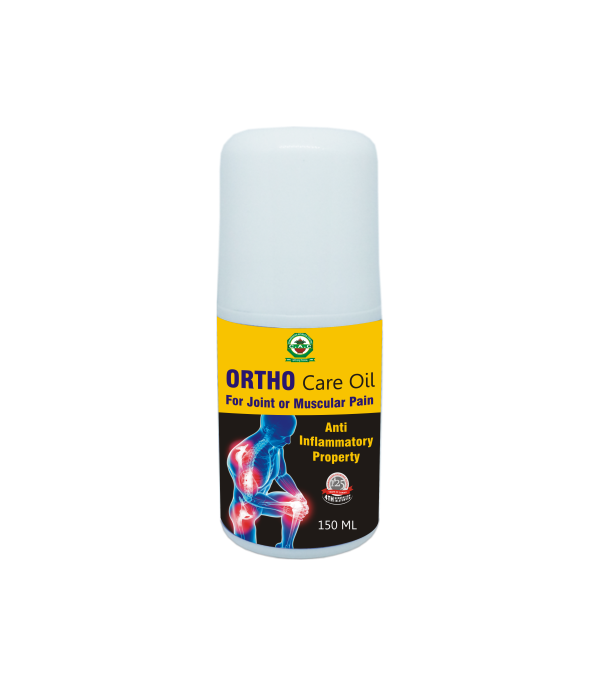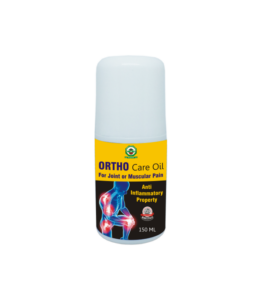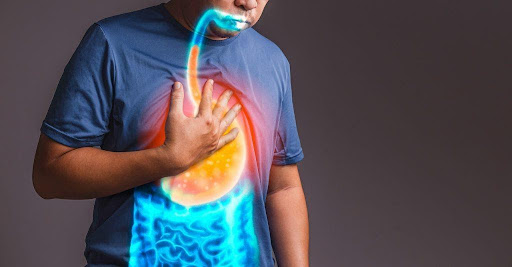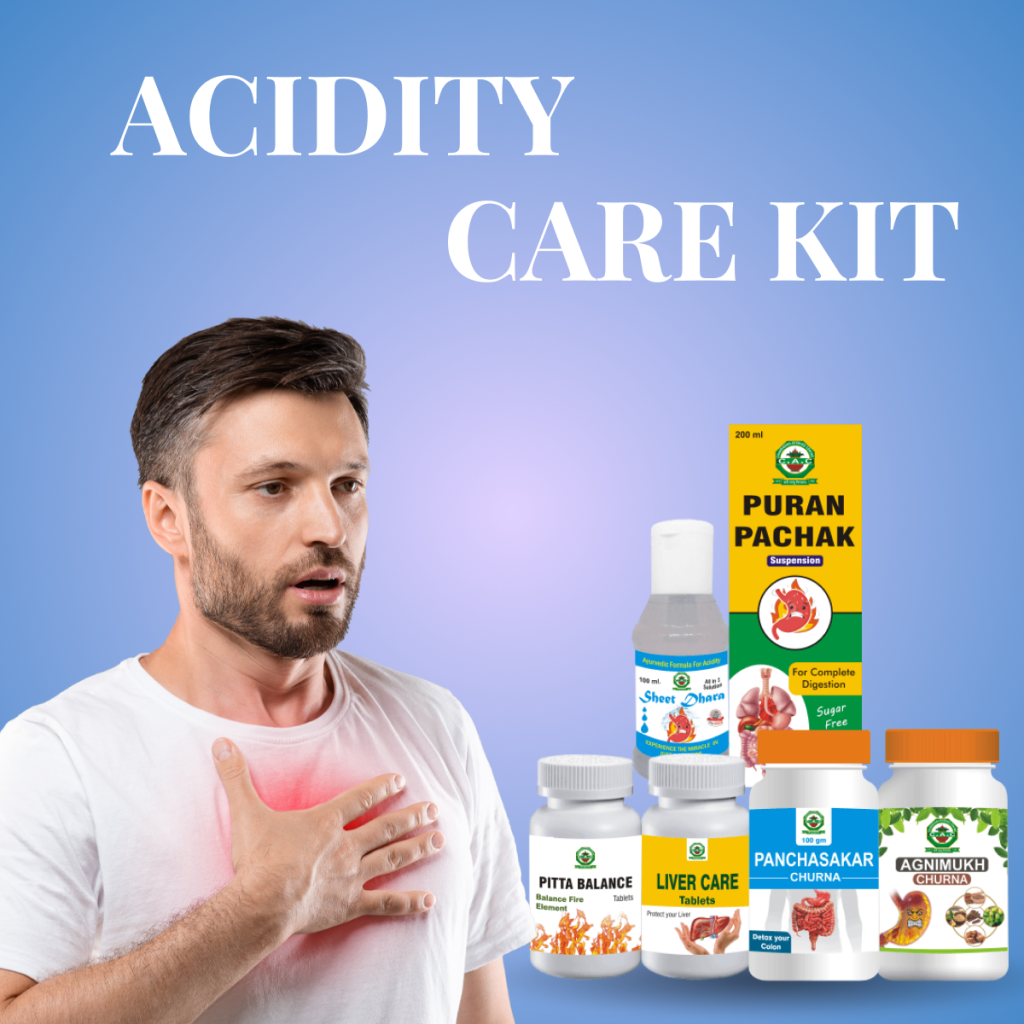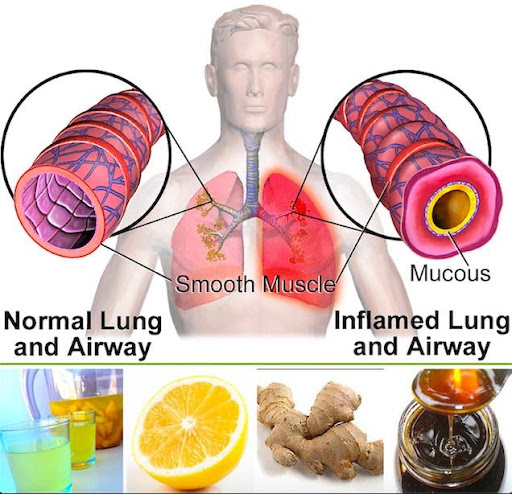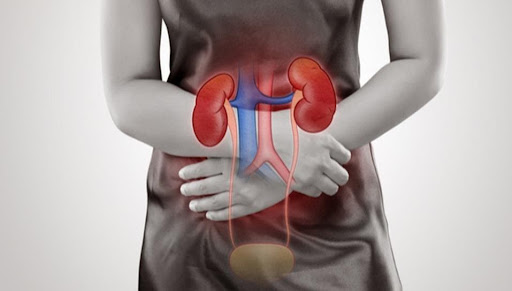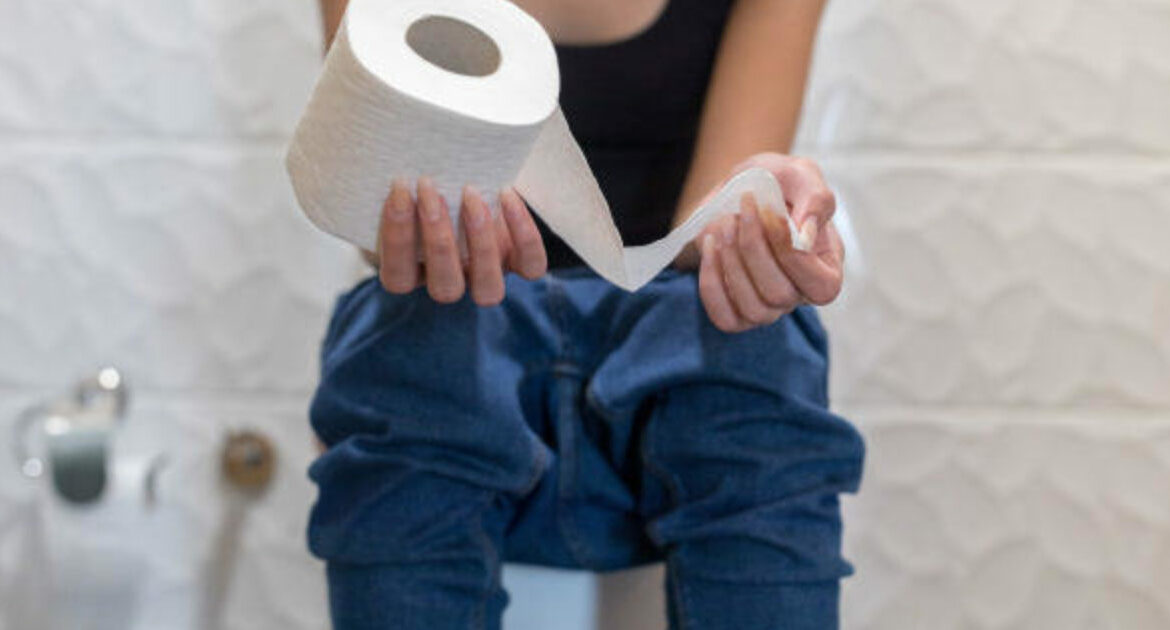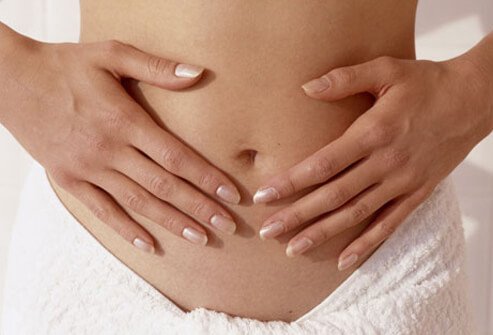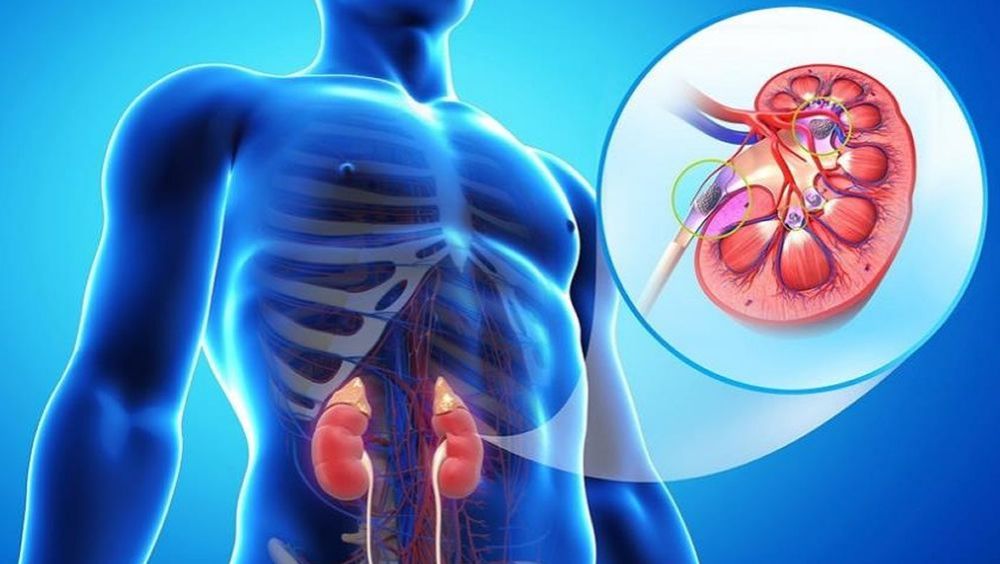Author Archives: Dr. Vaidya Karanvir Singh
How to treat avascular necrosis naturally?
- February 16, 2022
- Posted by Dr. Vaidya Karanvir Singh
- 0 Comment(s)
What is Avascular Necrosis?
- Avascular necrosis is a condition in which death of bone tissue occur due to a lack of blood supply. It is also known as osteonecrosis; it can lead to tiny breaks in the bone and leads to bone collapse.
- Dislocated joint can interrupt the blood supply to a section of bone. Avascular necrosis can also be caused due to use of high-dose steroid medications for long time.
- Anyone can be affected with AVN, but it’s commonly seen in people between the ages of 30 and 50.
Symptoms of AVN
- Symptoms are not seen in people in the early stages of avascular necrosis. As this condition worsens, affected joint may get hurt only when you put weight on it.
- Pain can be mild to severe and usually develops gradually. Pain might center on the groin region, thigh or buttock. Besides the hip, other areas that are likely to be affected are the shoulder, knee, hand and foot.
- Some people develop AVN on both sides (bilaterally) — such as in both hips or in both knees.
Causes of AVN
Main cause of AVN is the reduced blood flow to a bone. Reduced blood supply can be caused by:
- Any trauma to Joint or bone. An injury or trauma to joint may damage nearby blood vessels.
- Fatty deposits in blood vessels. The fat (lipids) can block small blood vessels that reduce the blood flow to the bones.
- Certain diseases. Medical conditions, like sickle cell anemia and Gaucher’s disease, also diminished blood flow to bone.
Risk factors
Risk factors for developing avascular necrosis include:
- Trauma
- Steroid use
- Bisphosphonate use
- Excessive alcohol use
- Certain medical Conditions
- Diabetes
- Pancreatitis
- Gaucher’s disease
- HIV/AIDS
- Sickle cell anemia
- Systemic lupus erythematosus
Complications
- If avascular necrosis is not treated properly then it worsens with time. Eventually, the bone can collapse. Due to avascular necrosis bones loses its shape that leads to severe arthritis.
Prevention
There are some preventive measures that will help to reduce your risk of developing avascular necrosis and improve your general health. These are
- Keep cholesterol levels low
- Avoid alcohol
- Limit steroid use
- Avoid smoking
Diagnosis
Doctor can make diagnose by doing physical exam and certain investigations.
Imaging techniques
Many disorders can cause joint pain. Imaging tests are helpful to diagnose the cause of pain. These may include
- X-rays.
- MRI and CT scan.
- Bone scan.
Treatment of AVN
Medications and therapy
In the early stages of avascular necrosis, symptoms are treated with medications and therapy. Your doctor might recommend:
- Non-steroidal anti-inflammatory drugs.
- Osteoporosis drugs
- Cholesterol-lowering drugs
- Blood thinners
- Rest
- Exercises
- Electrical stimulation
Surgical and other procedures
When medications doesn’t work or in advanced stage, your doctor may recommend surgery. The options include:
- Core decompression
- Bone transplant (graft)
- Bone reshaping (osteotomy)
- Joint replacement
- Regenerative medicine treatment
Ayurvedic management of AVN
- In Ayurveda best treatment of AVN is available. In Ayurveda treatment is done through the panchakarma as well as with medicines. Main benefits of Ayurvdic Treatment for AVN include
- Ayurveda treat the root cause of the disease. Where the modern medicines cannot treat it permanently and stop its progress, Ayurvedic treatment ensures the complete stoppage of the progress of condition.
- A complete reversal of AVN is possible in Ayurveda
- There is no risk of the ayurvedic treatment
- Treatment helps in achieving complete health
Chandigarh Ayurved centre provide complete treatment for AVN with panchkarma therapies as well as with medications. Chandigarh Ayurved centre provide combination of medications in ‘AVN care kit’ that not only lowers the pain but also stop the progress and treat the condition naturally.
How does Ayurvedic Medicine for AVN work?
There are a few main points, on which these medicines work
- Ayurvedic medicines help to reduce bone marrow edema.
- Helps in the restoration of the blood supply of the body naturally.
- Works to reduce joint effusion
- Clear the obstruction of channels of blood to re-establish blood flow.
- Improves process of bone formation.
- Helps in complete detoxification of the body.
- Removes dead tissue debris from the necrosed area.
- Helps in reducing inflammation of the joint.
Due to these benefits, this AVN care Kit helps you in the process of reversal of the condition.
About CAC AVN Care Kit
A single medicine cannot work for this complicated condition like avascular necrosis. So combinations of medicines in AVN care kit is effective to treat this condition. This is possible because of the set of the products.
AVN Care Kit
The AVN kit contains the following medicines
- Detox Premium Sachet
- Makar Rasayan Tablet
- Pain O Kill Syrup
- Nerve Up Tablets
- Pain O Kill tablet
For detailed description you can visit our website
https://www.chandigarhayurvedcentre.com/product/avn-care-kit/
All the medicines in this kit are pure ayurvedic , free from any kind of chemicals and made according to the principals of Ayurveda to treat the AVN naturally.
How quickly Ayurvedic treatment for AVN will work?
- When it comes to Ayurveda, there is misbelief that – Ayurveda works slowly. People, who don’t know or understand about Ayurvedic medicines, say so. In a condition like avascular necrosis, Ayurvedic medicines start working within the 12-15 days. So in 14 days, you will start getting positive signs of recovery from discomfort to comfort.
SCHIZOPHRENIA- Its causes, symptoms and treatment
- February 10, 2022
- Posted by Dr. Vaidya Karanvir Singh
- 0 Comment(s)
Introduction
Schizophrenia is a type of a mental disorder that is characterized by frequent or relapsed episodes of psychosis. Major symptoms include hallucinations (hearing voices), paranoia, disorganized thinking and dilusions .
Symptoms gradually come on, young adulthood phase, and in many cases it is never resolved. There is no objective diagnostic test though the diagnosis is often used to describe observed behavior that may come from numerous different causes. Besides the observed behavior, the doctors will also take the history that includes the reported experiences of the patient, and reports of others familiar with the patient, while diagnosing. To diagnose someone with schizophrenia, doctors are supposed to confirm that functions and symptoms impairment are present atleast for 6 months (DSM-5) or 1 month. Many people suffering from schizophrenia have other mental disorders, especially substance use disorders, anxiety disorders, depressive disorders and obsessive that is compulsive disorder.
Symptoms
There are many signs and symptoms that may vary from person to person. It also involves a range of problems related to thinking, patient’s behavior and their emotions.
Basic symptoms may include:
Delusions: These are known as false beliefs that does not occur in reality. For instance, patient thinks that they are being harmed or harassed. Delusions occur in almost all the patients suffering from schizophrenia.
- Hallucinations: These involve hearing or watching things that don’t exist. Hearing voices is one of the most common hallucination.
- Disorganized speech: Disorganized thinking is inferred from disorganized speech. Effective communication could be impaired, and answers to all questions may be completely unrelated.
- Abnormal motor behavior: Behavior isn’t focused on a goal, that’s why it’s hard to do tasks. Behavior may include resistance to instructions, bizarre posture, useless and excessive movementor a complete lack of response.
- Negative symptoms: This refers to inability of functioning normally. For instance, the patient may neglect personal hygiene or lack emotions. The patient may also loose interest in daily activities, socially inactive or inability to experience pleasure.
Symptoms can vary from severity over time, with periods of worsening and remission of symptoms
In men, the symptoms typically start from the early mid-20s and the symptoms may typically begin in the late 20s in the case of women. It is uncommon in children to diagnose with schizophrenia and rare for the old age people having age more than age 45.
Symptoms in teenagers
The symptoms of schizophrenia in teenagers are similar with the symptoms in adults, but the condition may be very difficult to recognize in them. This is because some of the early symptoms of the disease in teenagers are common for typical development during teen years, which may include:
- A drop in performance at school or college
- Irritability and depressed mood
- Lack of motivation
- Withdrawal from friends and family
- Trouble sleeping
- Insomnia
- Lack of appetite
Causes
The proper cause of schizophrenia is still unknown. But like diabetes and cancer, this disease is a real illness associated with a biological basis. Researchers have uncovered a number of things that appear to make someone more likely to get schizophrenia, that includes:
- Genetics: Schizophrenia can be a heredity disease, which means a greater likelihood to having this disease may be passed on from parents.
- Brain chemistry and circuits: Patients suffering from schizophrenia may be unable to regulate brain chemicals called neurotransmitters that control certain pathways of nerve cells that affect thinking and behavior.
- Brain abnormality: It can affect people without the disease.
- Environment: Things like viral infections, exposure to toxins like marijuana, this disease more often surfaces when the body is having hormonal and physical changes.
Diagnosis
The first step to diagnose schizophrenia is to consult a primary care doctor or psychiatrist. Ask them what steps you should take, by telling them the whole history especially if the person is not interested in seeking help.
The first thing the doctor should do is a complete medical exam and a psychological evaluation. They’ll ask about people in the family who may also still suffer from these symptoms or been diagnosed with the same disease, if they’ve ever been hospitalized for a mental condition and, how is the person’s behavior lately.
Treatment
In modern : The doctor can prescribe some of the modern drugs that may include:
- Aripiprazole
- Brexpiprazole
- Paliperidone
- Quetiapine
- Risperidone
- Ziprasidone
- Asenapine
- Cariprazine
- Iloperidone
- Olanzapine
- Clozapine
- Lurasidone
In Ayurveda : There are many ayurvedic medicines for schizophrenia in Ayurveda, but the most effective medicines are found in the CHANDIGARH AYURVEDA CENTRE (CAC).
This medi-kit comes in the name of “Schizophrenia go kit” that contains the following combinations of medicines:-
- Detox Premium Powder
- Active Plus Tablet
- Brodley Syrup
- Mann Mitra Tablet
- Rasayan Vati
- Brain Relaxant Churna
- Calm Sleep Tablet
The medicines are very effective in the cure of schizophrenia as they contain high quality natural herbs and their action potential is amazing as compared to other brands.
The brief detail about the medicines is given below:-
1) Detox Premium Powder:
Detox premium powder is composed of herbo-mineral preparation that contains ingredients such as shukta pishti, giloy shwet parpati, yavakshaar, moti pishti, shudhyog tablet, etc. These all ingredients in combination deal with the symptoms of Schizophrenia patients.
2) Active plus Tablet:
active plus Tablet is a pure herbo-mineral formulation prepared from best quality of herbs. This tablet is proved to be the best for patient’s physical and mental health, also helps in boosting up the immunity.
3) Brodley Syrup:
This syrup is prepared from various herbs that deal with the delusion, disorganized behavior, hallucination, lack of emotions, and inappropriate posture, etc.
4) Mann Mitra tablet :
It is helpful in making mind stong and helps in boosting the mind.
5) Rasayan Vati:
The ingredients used in this tablet shows antioxidant, anti-inflammatory, analgesic, antipyretic immune-modulator properties.
6) Brain Relaxant Churna:
It helps to deal with health conditions such as hallucinations, feeling dilusions, disordered thinking& impair daily functioning related to schizophrenia patients.
7) Calm Sleep tablet:
They helps to calm mind and help to pacify the nervous system & makes your body relax and light.
For more details, visit our website
https://www.chandigarhayurvedcentre.com/product/schizophrenia-go-kit/
Schizophrenia Go Kit
Ortho care oil
- February 10, 2022
- Posted by Dr. Vaidya Karanvir Singh
- 0 Comment(s)
Description of Ortho care oil
CAC ortho care oil is ayurvedic and purely herbal formulation. It helps to relax your muscles, joint pain and muscles cramps thus helpful in relieving pain. It balances all the three doshas of your body thus maintaining proper blood circulation. It provides soothing effect to the affected area of pain. It contains various combinations like Mahanarayan Tail, Mahavishgarbh tail, Laxadi tail etc. All these are natural pain relievers and having anti-inflammatory properties.
Ingredients
Each 50 ml of oil contains
- Mahanarayan Tail 15ml
- Maha Vishgarbh Tail 15ml
- Laxadi Tail 5ml
- Nirgundi Tail 5ml
- Devdaru Tail 2.5ml
- Tilparna tail 2.5ml
- Wintergreen oil 5ml
- Karpoor 1gm
- Nilgiri Tail 1gm
- Menthol 1gm
Description of ingredients
Mahanarayan Tail
It cures chronic joint and muscle pains and rigidity caused by arthritis, gout, etc. It is an effective cure for pains caused by injury especially in the chest, back and pelvic area. This oil is used to soothe pain related to aching joints, sore muscles and headaches.
Maha vishgarbh Tail
Maha Vishgarbha tail is very effective in acute vata and in acute muscular pain conditions .It gets readily absorbed through the skin, improves local blood circulation and immediately soothes sore muscles, painful conditions. It is useful in arthritis, sciatica, frozen shoulder, lumbago. It provides strength to joints and muscles.
Laxadi Tail
Laxadi Tail is used to treat various conditions like back pain, joint pain, spondolysis, overall strengthening of the body.
Nirgundi Tail
It is a great pain reliever and is widely used to treat orchitis, rheumatoid arthritis and osteoarthritis.This herbal oil can be used externally on wounds, swelling, and boils. Nirgundi Taila is a great weapon against harmful bacteria.It relieves itching, and is used to treat dysuria.It acts as a diuretic and helps in improving the immunity of a body.
Devdaru Tail
It is helpful to manage problems such as inflammation and pain related to arthritis due to its anti-inflammatory property. Devdaru oil can also be applied on wounds to prevent infections and speed up wound healing due to its antiseptic and anti-inflammatory property.
Tilparna oil
It is an essential oil that is used as a medicine to treat a variety of common diseases such as arthritis and skin ulcers.
Uses of Ortho care Oil
This herbal oil is beneficial in:
- Body pain
- Knee pain
- Frozen shoulder
- Rheumatoid arthritis
- Backache
- Sciatica
- Cervical spondylitis
- Osteoarthritis
- To heal injuries
- Strengthen joints and muscles.
ABOUT PRODUCT:
Chandigarh Ayurved Centre products are 100% safe and natural. MADE IN INDIA.
- This product is formulated under the guidance of MD Ayurveda expert.
- Natural and herbal products for overall health.
- Free from preservatives and chemicals.
- 131 years of serving mankind through ayurveda.
- Serving society 4th Generation in Ayurveda.
Ortho Care Oil
CHLAMYDIA(SEXUAL TRANSMITTED DISEASE)
- February 10, 2022
- Posted by Dr. Vaidya Karanvir Singh
- 0 Comment(s)
- Chlamydia is a STI (sexual transmitted disease )caused by a specific strain of bacteria known as chlamydia trachomatis which can damage female reproductive system
- Chlamydia is more common in women than men
- In women infection occur between ages 15 and 24.
- In some cases of women the infection can spread to the fallopian tubes and this cause a pelvic inflammatory disease (PID)
TRANSMISSION:
- It is transmitted through vaginal discharge or semen and also transmitted through genital contact or oral vaginal and anal sex without protection
- Touching genitals together
- Having a sexual partner who is having sex with other people
- Not using condoms
- Having a history of CHLAMYDIA or other infection
SYMPTOMS OF CHLAMYDIA:
In men –
- Painful ejaculation
- Penile discharge
- Testicular swelling
- Yellow or green discharge from the penis
- Pain in the lower abdomen
- Pain in the testicles
- Inflammation or infection in the eye
- Sore throat
In women –
- Painful intercourse
- Vaginal discharge
- Bleeding between periods
- Burning sensation while urinating
- Abnormal discharge from the vagina
- Pain in the lower abdomen
- Inflammation of the cervix
- Pus in your urine
- Increased need to pee
- Itching or burning in and around your vagina.
Chlamydia infection in the anus main symptoms are:
- Discharge
- Pain
- Bleeding from this area
CAUSES OF CHLAMYDIA :
- A partner who has an STD
- Men who have sex with men
- Unprotected sex
COMPLICATIONS OF CHLAMYDIA:
Females complications of infertility untreated chlamydia:
- PID infection that damage the uterus, cervix, and ovaries
- Infertility
- During pregnancy, the infection can pass to babies during birth, which can cause eye infections and pneumonia in newborns.
Male complications of untreated chlamydia:
- The infection can also spread to the prostate gland, causing a fever, painful intercourse, and discomfort in the lower back
- Epididymis
RISKS FACTORS OF CHLAMYDIA:
- Cervicitis — painful inflammation of the cervix that leads to vaginal discharge, bleeding and abdominal pain.
- Urethritis — painful inflammation of the urethra that can cause pain during sex, discharge from the urethral opening or vagina, and in men, blood in semen or urine.
- Proctitis — an inflammation of the lining of the rectum or anus.
- Spreading the infection to others
- Infecting other parts of the body, including the eyes, throat, and anus
- Infertility
- PID
- Ectopic pregnancy
- Higher risk of other STD (sexual transmitted disease)
- Prostate infection
- Infecting fetus during pregnancy
DIAGNOSIS OF CHLAMYDIA:
- Using a urine sample or swab.
PREVENTION OF CHLAMYDIA:
- Use barrier methods. Use condom or other barrier method to decrease the risk of infection.
- Communicate with your sexual partners. Openly discussing sti prevention and using barrier methods every time have sex.
- Avoid sharing sex toys wash thoroughly between each use and cover with a condom.
- Get tested regularly for STI with new partners.
- Avoid having oral sex
- Use protection during oral sex
IN AYURVEDA:
AAHAR (diet recommendations)
- Use of nutritious food is advised. Eggs, poultry, fresh fruits, nuts, cereals and vegetables should be eaten.
- light and nutritious diet
- sweet and sour foods
- avoid Indigestion, excess salt, alcohol & astringent materials
VIHAR (lifestyle changes)
- Follow (dincharya). This includes appropriate sleep and waking patterns, good quality and time for sleep, sexual activities, exercises
- Take adequate rest
- Do not sleep very late at night
- Stress, excessive exercise, unprotected and excessive sex, and suppression of urges (vegavidharan) must be avoided.
NATURAL CURE IN CHLAMYDIA:
- Garlic- Garlic has antibacterial and anti-inflammatory that kills bacteria and reduce inflammation
- Echinacea- Enchinacea boost immunity and help fight with bacterial and viral infections it may help reduce symptoms of chlamydia.
- Goldenseal is a natural antibiotic used as an immune system stimulant this medicinal plant may limit symptoms during an infection by reducing inflammation. Its antimicrobial properties fights against viruses and bacteria,
- Turmeric- Turmeric has powerful anti-inflammatory and antioxidant properties
- Olive tree extract- It has anti-inflammatory, antimicrobial, and antiviral activities
- Oil of oregano– It has healing compounds to natural infection fighter.
- Probiotics– Goat’s milk yogurt or kefir, coconut kefir, kombucha and amasai have high levels of healthy bacteria that will help you fight chlamydia and other “bad” bacteria.
- Proper diet
- Yogurt in the diet it boosts immunity empowers the immune system to fight against the harmful bacteria. It also a natural probiotic
- Vitamins are essential for carrying out body functions properly vitamin c is a great antioxidant that regulates white blood cell function.
- Aromatherapy essential oil. This oil curing the inflammation is tea tree oil. The anti-inflammatory and antiseptic properties of this oil cure the infection (8).
Other oils are such as lavender and myrrh oil.
- Stay hydrated water cleanses the body by removing toxins, poisonous metabolic waste, and harmful substances
- Avocado are enriched with nutrients and vitamins that protect our system from foreign bodiesit has antioxidants properties that inhibit the infection and make the body healthy.and also has anti-inflammatory properties that helps reduce the pain and swelling felt during chlamydia.
- Lemon is used for treating chlamydia, owing to the abundance of vitamin c in it.
- Apple cider vinegar can cure chlamydia as it helps in keeping the vagina sterile by ejecting all the parasites and flushing the infectious and foul-smelling
- Green tea is one such herbal remedy for chlamydia. It has antioxidants propertie that keep the body protected from chlamydia infections
- Aloe vera it has anti-inflammatory and antifungal properties it is also great for detoxification and healing compounds
- Usnea it is antimicrobial in nature cure the infections the herb is highly antiseptic
- Sage sage tea is powerful in curing the infection and sage is antimicrobial and antioxidant propertries that prevents from infections
- Cat’s claw is used in treating many sexually transmitted diseases and bacterial infections.
ACIDITY
- February 10, 2022
- Posted by Dr. Vaidya Karanvir Singh
- 0 Comment(s)
- Acidity is excessive acid production in the stomach causing heartburn and acid reflux
- Acidity also caused due to overproduction of gastric juices in the stomach
- IN AYURVEDA acidity is co relate with AMLAPITTA
SYMPTOMS OF ACIDITY:
- Stomach inflammation
- Throat inflammation
- Trouble during swallowing
- Restlessness
- Bad burps
- Nausea
- Indigestion
- Bad breaths
- Constipation
- Sour taste in mouth
CAUSES OF ACIDITY:
- Stress
- Obesity
- Consumption of spicy and non-vegetarian foods
- Smoking and alcohol
- peptic ulcers, gastroesophageal reflux disease, stomach tumors, etc.
- Medications like non-steroidal anti-inflammatory drugs.
- Bad Lifestyle Habits such as smoking, eating large meals, lying down immediately after meals and eating late at night
RISK FACTORS OF ACIDITY:
- Obesity
- Smoking (active or passive)
- Low levels of physical exercise
- Medications like drugs for asthma, antihistamines, painkillers, sedatives, and antidepressants
- Pregnancy
INVESTIGATIONS:
- Gastroscopy (Upper Gastrointestinal Endoscopy)
- Oesophageal pH monitoring
- Gastrin levels in blood
- Ba Meal x-ray
- Serology + histology for H. Pylori
- Stool routine examination
HOME REMEDIES FOR ACIDITY:
- Banana is very important for gut and stomach health banana are rich in potassium and increase the production of mucus in the stomach
- Cold milk It is a known fact that milk contains a high amount of calcium Calcium helps to maintain the Ph balance and aids in proper digestion
- Butter milk Buttermilk contains lactic acid that neutralizes the acidity in the stomach. The lactic acid further soothes the stomach
- Fennel seeds it also contains anti-ulcer properties it cools the lining of the stomach and helps in relieving constipation as well.
- Basil leaves or Tulsi it stimulates stomach to produce more mucus which in turn helps to relieve heartburn
- Pineapple juice is provide relief from acidity and heartburn.
- Raw almonds were natural remedy for ulcers and heartburn.
- Mint leaves or pudina can also help when suffering from indigestion or acidity. Mint leaves reduce the burning and pain
- Clove helps to soothe inflamed and damaged stomach lining thus proving very beneficial for heartburns and stomach spasms.
- Ginger helps in alleviating acidity ginger also decreases inflammation and nausea and calms the stomach muscles.
- Garlic is powerhouse of antioxidants
- Amla
- Soak raisins
- Drink rosewater
- Drink coriander water (infusion) throughout the day.
- Coconut water
PREVENTIONS:
- Limit high fat foods
- Eat smaller and frequent meals
- Chew your food properly
- Avoid tight jeans
- Chew gum
- Spend some time in sun
- Drink lots of water
- Chew food properly
- Do not overeat.
- Do not remain hungry for long hours
- Don’t skip meals (never a lunch).
- Avoid irregular eating.
- Maintain a moderate weight
- Have early dinners
- Avoid foods containing an excess amount of garlic, salt, oil, chillies
- Avoid lying down immediately after food
- Sleep on your left side sleeping on your right side may worsen reflux symptoms at night
- Follow a low carb diet
- Don’t drink too much coffee
CAC MEDICATONS FOR ACIDITY:
- AGNIMUKHA CHURNA- It gives effective results in indigestion, anorexia, abdominal pain, constipation, loss of appetite, flatulence, bloating, intestinal gas, intestinal gas, etc.
- PURAN PACHAK- reduce the Acidity and shows Antacid, Digestive, Anti-inflammatory, Analgesic, Expectorant, and Antioxidant properties.
- PANCHSAKAR CHURNA- It helps n removing all toxins from the body & provides good results in acidity.
- SHEET DHARA SYRUP– naturally relieve the symptoms like bloating, blenching, nausea, vomiting, feeling of discomfort, etc. The regular use of this herbal syrup neutralizes the high acid content, reduce abdominal pain, & cramps.
- LIVER CARE TABLET– These herbs balances excess Pitta Dosha and helps in problems like abdominal bloating ,flatulence, abdominal pain, loss of appetite and indigestion.
- PITTA BALANCE TABLET– Pitta doshas is composed of a fire element that digests almost everything that a person eats or drink.
ACIDITY CARE KIT
Some Simple ways to relieve Chest congestion
- February 10, 2022
- Posted by Dr. Vaidya Karanvir Singh
- 0 Comment(s)
What is chest congestion?
- Chest congestion is the mucus accumulation in the lungs and bronchi. Chest congestion may cause you to hear or feel wheezing or crackling sounds while breathing.
What Causes Chest Congestion?
- Infection with flu virus is the common causes of chest congestion and when the infection spread from upper respiratory tract (nasal passages, throat) into the lower respiratory tract (bronchi and lungs) then chest congestion occurs.
- Your body tries to remove infectious agents by producing mucus, to trap them and prevent your lungs and airways. Due to this mucus chest congestion occurs.
- If chest congestion started from a cold, then symptoms like stuffy nose, sore throat, and sneezing occurs.
- Mucus produced by lungs that forms a protective lining in certain parts of the body. Mucus prevents drying out of the areas and helps against many kinds infectious agents including viruses and bacteria.
- In a healthy person some mucus is required, but too much can be uncomfortable. Excess may be caused by:
- Infections, like common cold or flu
- Seasonal Allergies
- Air pollution
- Irritation of the nose, throat, or lungs
- Smoking tobacco products
- Lung diseases, like pneumonia, COPD, Bronchitis, lung cancer etc.
How to get rid of phlegm and mucus?
Taking fluids, keeping the head elevated, and using nasal sprays may help to get rid of phlegm and mucus. Taking following measures can be helpful to eliminate excess mucus and phlegm
Taking plenty of fluids
- Taking plenty of fluids is helpful to stay hydrated and keep mucus thin. When a person is sick with a cold, taking extra fluids can thin the mucus and help the sinuses to drain. By keeping mucus thin it will help to prevent chest congestion. Taking warm liquids is beneficial.
Keeping the air moist
- Dry air cause irritation in the nose and throat and leads to more mucus production. Using a cool mist humidifier in the bedroom can be helpful for better sleep, clear chest congestion, keeping the nose clear and preventing a sore throat.
Applying a warm, wet washcloth to the face
- This can be effective way to get relieve from sinus headache. Inhaling through a damp cloth is a quick way to return moisture to the nose and throat. The heat will help to get relief from pain and pressure.
Not suppressing a cough
- Don’t use medications to suppress cough .However; coughing is the body’s way to keeping secretions out of the lungs and throat. You can use cough syrups.
Keeping the head elevated.
- Lying flat increase your discomfort by favoring extra buildup of mucus. Due to this mucus is collecting at the back of the throat that leads to irritation in throat.
Use of saline nasal spray
- To use a saline nasal spray or irrigator can be helpful to clear out mucus and allergens from the nose and sinuses. You can use sterile sprays that contain only sodium chloride, and be sure to use distilled or sterile water when irrigating.
Oil massage on chest.
- By massaging warm mustard oil on chest by adding some salt in it, will give effective results in chest congestion.
Gargling with salt water
- One teaspoon of salt in a glass of warm water can be used for gargling many times in a day. This is beneficial in irritated throat and helpful to clear away mucus.
Using eucalyptus
- Eucalyptus oil can be applied directly to the chest. Adding few drops of eucalyptus oil to a diffuser or a warm bath will be helpful to clear the nose.
Avoid smoking
- Smoking cause the body to produce more mucus so by avoiding smoking one can get relief from chest congestion.
Keeping allergies in check
- Take preventive measures to avoid seasonal allergies that can lead to a runny or stuffy nose, as well as excess mucus and phlegm. So keep your immunity high.
Avoiding irritants
- Exposure to pollution, Chemicals can cause irritation in the nose, throat and lower airways. This results in production of mucus.
Blowing the nose gently
- It may be tempting to keep blowing until thick mucus comes out. However, doing so too forcefully may hurt the sinuses, leading to pain, pressure, and possibly infection.
Use of herbal tea
- Drinking herbal tea daily will also be effective. As it will prevent many kind of infections, allergies that leads to chest congestion. You can make herbal tea by using ginger, tulsi, ela, lemon, honey etc.
Avoiding alcohol and caffeine
- These substances lead to dehydration if taken in excess quantity. So avoid these beverages.
Eating plenty of fruits
- Studies shows that diet rich in fiber from fruit, and soy, may lower the risk of respiratory problems that can cause phlegm.
Steam
- Taking steam is very effective to prevent your chest congestion. As it help to loosen the mucus and relieve chest congestion.
URINARY TRACT INFECTION (UTIs)
- February 10, 2022
- Posted by Dr. Vaidya Karanvir Singh
- 0 Comment(s)
- Urinary Tract Infection (UTI) is a common condition where bacterias cause an infection in the urinary tract.
- Woman have more chance of getting a urinary tract infection is high because women have a shorter urethra than men. Bacteria don’t have to travel very far to reach and infect a woman’s bladder.
- As per Ayurveda, all urinary tract infections are co related with MUTRAKRICCHRA which includes kidney disorders and urinary tract infections.
- Bacteria caused urinary tract infection is ESCHERICHIA COLI and this present in the bowel and around the anu
- UTI IN MALES – Young males who develop UTIs may have a congenital malformation in a part of urinary system
- Males ages 20–35 are generally at low risk of developing UTIs unless it is caused by an STI (sexually transmitted infection) and having multiple sex partners and having sex without using a condom
- UTIs in men are more common with older age because in older man develop noncancerous enlargement of their prostate gland, called benign prostatic hyperplasia.
SYMPTOMS IN URINARY TACT INFECTION:
- Dysuria (pain or burning when urinating)
- Urinary retention
- Urinary urgency
- Increased urinary frequency
- Nocturia (waking up to urinate at night)
- in males – Milky discharge from the penis and cloudy urine
- Foul-smelling urine
- Pain near the bladder
- Hematuria (blood in the urine)
- Incontinence (loss of bladder control)
- Flank pain
- Fevers and chills
- Nausea
- vomiting
- burning sensation while urinating
CAUSES OF URINARY TRACT INFECTION:
- STIs
- Urethral stricture (blockage of the urethra)
- Previous UTIs
- Diabetes
- Immune system problems
- urinary catheter for a prolonged time
- Prostate enlargement
- Congenital malformation of the urinary tract
- Cancer of the urinary tract
PREVENTING URINARY TRACFT INFECTION:
- Urinate when feel the need.
- Don’t hold it in
- Drink adequate fluids.
- During toileting, wipe from front to back.
- Keep genital area clean and dry.
NATURAL CURE IN URINARY TRACT INFECTION:
- VITAMIN C
Vitamin C can help increase acidity in the urine and kill off the bacteria vitamin sources is :
- Red peppers
- Oranges
- Grapefruits
- Kiwifruit
- CRANBERRY/BLUEBERRY JUICE Drink cranberry juice or juice that is unsweetened Cranberry is the best, and Blueberry tastes so good! Cranberries and blueberries help prevent infection by stopping the bacteria from urinary tract.
- GARLIC has antimicrobial properties and able to block bacteria growth and prevent UTI’s.
- DRINK LOTS OF WATER. Drinking lots of water, and emptying your bladder when you need to helps flush harmful bacteria
Recommend 8 glasses a day
- AVOID BLADDER IRRITATING FOODS IN UTI citrus or very acidic foods, artificial sweeteners, caffeine, alcohol
- MAINTAIN PROPER HYGIENE: women can wipe from front to back after urinating to avoid spreading bacteria
- Also urinating immediately after sex can decrease the risk for UTIs.
- PARSLEY TEA Parsley has a mild diuretic effect which help flush UTI-causing bacteria
- CHAMOMILE TEA Chamomile possesses a weak diuretic effect and contains plant compounds with anti-inflammatory and antibacterial properties that helps to treat infection
- GREEN TEA it has anti- inflammatory and antimicrobial properties
- MINT Mint tea is used as a natural remedy for UTIs.
- D-MANNOSE it is a type of simple sugar that’s frequently used to prevent and treat mild UTIs.
- MARSHMALLOW ROOT Marshmallow has a softening demulcent effect on irritated mucous membranes of the urinary tract.
- UVA URSI (BEARBERRY LEAF) compounds present in the plant have exhibited potent antimicrobial capabilities
- NETTLES –nettle is mineral-rich plant and mild diuretic. It helps to flush the urinary tract and this has also mild anti-inflammatory properties
- YARROW –it has antimicrobial, astringent, and diuretic properties
- RED CLOVER –red clover is a gentle diuretic that helps with balancing hormones. it is known as a blood cleanser
- DANDELION ROOT – it also acts as a diuretic, kidney, and liver cleanser
- SUPPLEMENTS BENEFICIAL FOR UTIS
Vitamin C
Vitamin D3
CAC MEDICATION IN URINARY TRACT INFECTION:
LIVER CARE TABLET
IT HELPS RO balancing pitta doshas AND ALSO improve the circulation of blood and it also helps or prevent against burning sensation of urine and removes urinary infection Dosage: Take one tablet twice daily
UTI CARE TABLET
it treats the root cause of diseases IT treats problems related to kidney, urinary bladder, urethra and ureters. It ALSO removes the kidney stones, renal colic, painful micturition, hypertension, and burning sensation during the passage of urine. it has antioxidant and anti -inflammatory properties
Dosage: take 1 tablet twice daily with plain water after meal.
TRIKATU SYRUP
Trikatu syrup is it removes excess of Kapha doshas AND detoxifies the body. it has anti-inflammatory , analgesic and antioxidant properties. It boosts metabolism and works in dysuria, painful micturition, and reduce inflammation of the kidney
Dosage: 2 tsp twice daily
DETOX PREMIUM POWDER
IT helps to reduce inflammation and burning sensation caused due to UTI infection. It has an anti-inflammatory action. It also helps to remove toxins due to its antioxidant properties. AND ALSO IT HAS antibacterial action
Dosage: Take one sachet twice a day
SHEET DHARA
THIS works on doshas of the body especially pitta doshas AND IT helps to reduce burning sensation during micturition.
Dosage: Take 1 teaspoon twice daily
FAQs FOR PILES (HEMORRHOIDS)
- February 10, 2022
- Posted by Dr. Vaidya Karanvir Singh
- 0 Comment(s)
Q:1 What is a hemorrhoid?
“Hemorrhoids” are termed as coagulated blood lumps formed due to swelling and inflammation. This happens as a result of pressure being exerted on these blood vessels The size of piles can vary, and they are found inside or outside the anus.
Q:2 What is the newest surgical technique for treating hemorrhoids?
Stapled HEMORRHOIDECTOMY is the newest surgical technique to treat hemorrhoids.
It does not remove the hemorrhoids themselves it removes the lax tissue surrounding the hemorrhoid that has allowed it to protrude.
Q:3 Men and women suffer from hemorrhoids at about the same rate?
Hemorrhoids occur in both men at women and they occur most often in adults between 44 and 66 years of age.
Q:4 Everyone has hemorrhoids True or False?
All have hemorrhoids pillow-like clusters of veins located just below the surface of the mucous membranes of the anus and rectum
Q:5 Is there a loss of bowel control after Piles or Hemorrhoid surgery?
It is rare to observe loss of bowel control post piles or hemorrhoid surgery
Q:6 What is the difference between internal and external Piles?
External hemorrhoids are on the outside around the anus, while internal hemorrhoids are inside the anal canal.
Q:7 What causes Piles?
- Straining during bowel movements
- Sitting for long periods of time on the toilet
- Having chronic diarrhea
- chronic constipation
- Being obese
- pregnant
- Having anal intercourse
- Eating a low-fiber diet
- Regular heavy lifting
Q:8 What risk factors are associated with Piles?
- Aging: The Mucosal lining of anus becomes more sensitive with the age and the pressure from straining and may lead to complications.
- Obesity: lack of physical activities, can lead to obesity and further piles
- Pregnancy: Piles during pregnancy as a result of hormonal changes making the veins relax. Piles can leads to itching and painful and piles disappear within few weeks after Post Pregnancy.
- Diet and lifestyle: Diet and lifestyle can also be reasons behind generation of piles. Low-fiber diet, alcohol consumption, eating excessive spicy food consumption, can cause formation of piles. Low-fiber diet
Q:9 Which are the symptoms of Piles?
- Itching around the anus
- Blood in the stools
- pain during defecation
- Presence of hard lump around the anus
- Discharge of mucus while emptying the bowels
- Sore and red anus
- Sense of fullness in the anus
Q:10 What are the complications associated with Piles?
- Infection
- Anal fistula
- Gangrene
- Incontinence in rare cases
- Anemia due to excessive blood loss
Q:11 What are the prevention of piles?
- Eat high-fiber foods.
- Drink plenty of fluids
- Consider fiber supplements
- Don’t strain
- Go as soon as you feel the urge
- Exercise. Stay active to help prevent constipation and to reduce pressure on veins
- Avoid long periods of sitting. Sitting too long, particularly on the toilet, can increase the pressure on the veins in the anus.
Q:12 What are the types of piles according to dosha in Ayurveda?
- pitta might tend to experience inflamed, bleeding hemorrhoids that are soft and red. Other symptoms include fever, diarrhea, and a feeling of thirst.
- vata may experience a high level of pain, constipation, and black hemorrhoids with a rough, hard texture.
- kapha may have poor digestion and hemorrhoids that are slippery, light or white in color, soft, and large in size.
Q:13 What are the ayurvedic treatment for piles?
- Medication, or bhaishajya chikitsa – minor hemorrhoids can be treated with medication only.
- Herbal application, or kshara – Kshara is a caustic, alkaline paste used to manage hemorrhoids. Kshara is applied to the hemorrhoid using a specialized device called a slit proctoscope.
- Surgical intervention, or sastra chikitsa- Your Ayurvedic practitioner may recommend a therapy called kshara sutra. Kshara sutra uses special medicated thread to tie a hemorrhoid off at the base.
- Cauterization, or agnikarma– External hemorrhoids can be cauterized using infrared heat.
FAQs FOR IBS (IRIRITABLE BOWEL SYNDROME)
- February 10, 2022
- Posted by Dr. Vaidya Karanvir Singh
- 0 Comment(s)
Q:1 What is IBS irritable bowel syndrome?
Irritable bowel syndrome (IBS) is a chronic gastrointestinal (GI) disorder that refers to a group of symptoms that affect your digestive system
Q:2 How common is IBS?
IBS is the most common functional gastrointestinal (GI) disorder. It affects males and females, adults and children.
Q:3 What are symptoms of IBS (irritable bowel syndrome)?
- Abdominal pain
- Bloating
- Constipation
- Diarrhea
- Flatulence
- Headache
- Backache
- Loss of appetite
- Mucus in bowl movements
- Feeling of incomplete movements
- loose and more frequent stools
Q:4 Who is more likely to develop IBS?
Women are more prone as men to be diagnosed IBS and IBS is common in people age 45
Q:5 What food should people with IBS avoided?
- Fruits, such as apples, pears, peaches, cherries, mangoes, pears and watermelon
- Vegetables, such as artichokes, asparagus, Brussels sprouts, broccoli, beetroot, garlic and onions
- Sweeteners, such as honey and agave nectar
- Products with high fructose corn syrup
- Chocolate
- Dairy products
- Nuts
- Wheat products
- Caffeine
- fatty foods
Q:6 What to eat in IBS?
- Dairy: rice milk, almond milk, coconut milk, lactose-free yogurt
- Fruit: Bananas, blueberries, , grapefruit, honeydew, kiwi, lemon, lime, oranges and strawberries
- Vegetables: Bamboo shoots, bean sprouts, carrots, chives, cucumbers, eggplant, ginger, lettuce, olives, potatoes, spring onions
- Protein: Beef, pork, chicken, fish, eggs
- Nuts/seeds :Almonds, macadamia, peanuts, pine nuts and walnuts (10 – 15 each a day )
- Grain: Oat, rice bran, gluten-free pasta, such as rice, corn, quinoa, white rice, corn flour and quinoa
Q:7 is there an IBS diet?
FODMAPs are fermented (digested) by intestinal bacteria, which can lead to symptoms of abdominal pain, excess gas, constipation, and diarrhea. Following a low-FODMAP diet may help to reduce gastrointestinal symptoms
Q:8 what is low FODMAP diet?
The low FODMAP diet relieves symptoms of IBS at home FODMAPs (fermentable oligosaccharides, disaccharides, monosaccharides, and polyols) Foods that include FODMAPs include:
- Dairy products such as milk, yoghurt, ice-cream, and cheeses
- Vegetables such as onions, garlic, broccoli, cabbage, and mushrooms
- Sweeteners such as honey, sorbitol, and high fructose corn syrup
- Wheat such as breads, cereals, pastas, and crackers
- Fruits like apples, peaches, pears, apricots, cherries, and blackberries.
Q:9 Are there different types of IBS?
There are four types of IBS, based on a person’s typical stool consistency.
- IBS with constipation, or IBS-C:
hard or lumpy stools at least 25% of the time
loose or watery stools less than 25%of the time
- IBS with diarrhea, or IBS-D:
loose or watery stools at least 25%of the time
hard or lumpy stools less than 25%of the time
- Mixed IBS, or IBS-M:
hard or lumpy stools at least 25%of the time
loose or watery stools at least 25%of the time
- Unsubtyped IBS, or IBS-U:
hard or lumpy stools less than 25%of the time
loose or watery stools less than 25% of the time
Q:10 Can the menstrual cycle affect IBS symptoms?
- Female patients with bowel disease commonly report worsening of symptoms in the menstrual cycle.
- Bowel function appears to be influenced by changes in the level of female hormones.
- Symptoms can become worse at the time of menstrual periods.
- Premenopausal female patients with IBS become much more symptomatic during the menstrual phase of the cycle than other stages of the cycle.
Q:11 How do I know if I have IBS?
Diagnose IBS by review of your symptoms, a physical examination, and selected diagnostic procedures
Q:12 Are there any complications of IBS?
While IBS can cause pain and stress, it does not cause any permanent damage to the bowel or lead to cancer or any other major illness.
Q:13 How is IBS different then IBD?
Primary differences between Inflammatory Bowel Disease (IBD) and Irritable Bowel Syndrome (IBS). IBD is an autoimmune disorder that causes swelling and ulcerations in the bowel. in IBS problem is motility (how the bowel moves contents through our intestines) and sensitivity (how the brain interprets sensations in the bowel).
Q:14 What are other names for IBS?
Irritable bowel syndrome has also been called mucous colitis, spastic colon, nervous colon, and functional bowel disease.
DIET CHART FOR CHRONIC KIDNEY DISEASE
- February 9, 2022
- Posted by Dr. Vaidya Karanvir Singh
- 0 Comment(s)
INTRODUCTION
- Chronic kidney disease (CKD) means your kidneys are damaged and cannot filter blood the way they should. The main risk factors for developing kidney disease are diabetes, high blood pressure, heart disease, and a family history of kidney failure. In the early stages of chronic kidney disease people might have few signs or symptoms. You might not realize that you have kidney disease until the condition is advanced.
- Treatment for chronic kidney disease focuses on slowing the progression of kidney damage, usually by controlling the cause. But, even controlling the cause might not keep kidney damage from progressing. Chronic kidney disease can progress to end-stage kidney failure, which is fatal without artificial filtering (dialysis) or a kidney transplant.
SUNDAY | |
| BREAKFAST (8:00-8:30AM) | 1 cup Vangibath+1 cup toned milk/ 1 cup tea (100ml) |
| MID-MEAL (11:00-11:30AM) | 1 apple (100gm) |
| LUNCH (2:00-2:30PM) | 1 cup rice+2 chapathi+1/2 cup snake gourd dal (red gram dal leached in hot water for 2 hours)+1/2 cup cabbage sabji+ 1/2 cup curd |
| EVENING (4:00-4:30PM) | 1 cup puffed rice 1 cup toned milk |
| DINNER (8:00-8:30PM) | 1 cup rice+1/2 cup cabbage sabji |
MONDAY | |
| BREAKFAST (8:00-8:30AM) | 1 cup capsicum rice+1 cup toned milk/ 1 cup herbal tea (100ml) |
| MID-MEAL (11:00-11:30AM) | 1 pear (100gm) |
| LUNCH (2:00-2:30PM) | 1.5 cup rice+1/2 cup lauki dal(red gram dal leached)+1/2 cup bhindi(leached) sabji+ 1/2 cup curd |
| EVENING (4:00-4:30PM) | 1 cup toned milk/tea (100ml)+ 4 biscuits |
| DINNER (8:00-8:30PM) | 1 cup rice+ 1/2 cup bhindi(leached) sabji |
TUESDAY | |
| BREAKFAST (8:00-8:30AM) | 3 rice dosa+1/2 cup sambhar (100ml), (red gram dal-leached, onion, ladies finger, bottle gourd)+1tsp tomato chutney+1 cup toned milk/ 1 cup tea (100ml) |
| MID-MEAL (11:00-11:30AM) | 4 Jambu fruits/ strawberries(small) |
| LUNCH (2:00-2:30PM) | 1 cup rice+2 chapathi+1/2 cup mix veg sambhar (leached (red gram dal, ladies finger, bottle gourd), onion)+ 1/2 cup lauki sabji+ 1/2 cup curd |
| EVENING (4:00-4:30PM) | 3 Cracker biscuits+ 1 cup toned milk/tea (100ml) |
| DINNER (8:00-8:30PM) | 1 cup rice+ 1/2 cup lauki sabji |
WEDNESDAY | |
| BREAKFAST (8:00-8:30AM) | 4 rice Idly + 1/2 cup sambhar (100ml)(red gram dal-leached, onion, ladies finger, bottle gourd)+1 tsp. methi chutney+1 cup toned milk/ 1 cup tea (100ml) |
| MID-MEAL (11:00-11:30AM) | Pineapple (100gm) |
| LUNCH (2:00-2:30PM) | 1 cup rice+2 chapathi+1/2 cup ridge gourd sabji+1/2 cup methi dal (both methi and red gram dal leached) + 1/2 cup curd |
| EVENING (4:00-4:30PM) | 1 cup toned milk/tea (100ml)+ 4 biscuits |
| DINNER (8:00-8:30PM) | 1 cup rice+1/2 cup ridge gourd sabji |
THURSDAY | |
| BREAKFAST (8:00-8:30AM) | 1 cup vermicelli upma+1 cup toned milk/1 cup tea(100ml) |
| MID-MEAL (11:00-11:30AM) | Musk melon (100gm) |
| LUNCH (2:00-2:30PM) | 1.5 cup rice+ 1/2 cup capsicum(leached) sabji+ 1/2 cup ridge gourd dal(red gram dal leached)+ 1/2 cup curd |
| EVENING (4:00-4:30PM) | 1 cup poha (rice flakes)+ 1 cup toned milk/tea (100ml) |
| DINNER (8:00-8:30PM) | 1 cup rice+ 1/2 cup capsicum(leached) sabji |
FRIDAY | |
| BREAKFAST (8:00-8:30AM) | 3 chapatti+ capsicum curry-1/2 cup+1 cup toned milk/ 1 cup tea (100ml) |
| MID-MEAL (11:00-11:30AM) | papaya (100gm) |
| LUNCH (2:00-2:30PM) | 1 cup rice+2 chapatti +brinjal (leached) sabji+1/2 cup tomato dal(green gram dal leached)+ 1/2 cup curd |
| EVENING (4:00-4:30PM) | 1 cup toned milk/tea (100ml) + 4 biscuits |
| DINNER (8:00-8:30PM) | 1 cup rice+ brinjal (leached) sabji |
SATURDAY | |
| BREAKFAST (8:00-8:30AM) | 1 cup tomato rice + methi chutney- 2 tsp+1 cup toned milk/ 1 cup tea (100ml) |
| MID-MEAL (11:00-11:30AM) | 1 small wedge (100gm) watermelon |
| LUNCH (2:00-2:30PM) | 1.5 cup rice+1/2 cup mix veg sambhar (leached(red gram dal),ridge gourd, snake gourd, bottle gourd)+1/2 cup ivy gourd (parmal) sabji+ 1/2 cup curd |
| EVENING (4:00-4:30PM) | 1 cup toned milk/tea (100ml)+ 4 biscuits |
| DINNER (8:00-8:30PM) | 1 cup rice+ 1/2 cup parmal sabji |
DO’S AND DONT’S
Do’s:
- Limit your fluid intake
- Use high in potassium green leafy vegetables/ pulses.
- Maintain diary of foods that can be consumed, avoided and limited.
Don’ts:
- Avoid sodium, processed, canned foods, and foods that containing preservatives.
- Avoid foods rich in phosphorus such as meat, chicken, legumes and pulses, dairy products, nuts.
- Avoid high potassium foods that cannot be leached such as banana, mango, coconut water, avocado, potatoes, yoghurt, whole milk, pumpkin, beans, fish, tomato sauce, beet root, chilies)
- Avoid sweets and other snacks that are rich in sodium and potassium.


